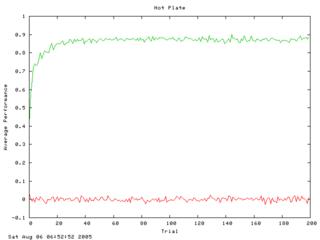

Also, I wrote a bunch of unit tests to make sure each functional component is working correctly even after I make big changes. (I decided to write my own C++ unit testing framework. Check here if you're interested: http://quicktest.sf.net)
The purpose of adding all these tests is so I can scale up the learning task complexity a little at a time and find out exactly where problems occur. This seems much more reasonable than throwing a bunch of complicated systems together (learning agent, physics simulation, etc.) and hope it can learn efficiently.
Another big change has been in the area of input representation. Now the agents' inputs are much more customizeable. You can choose between 'continuous' and 'discrete' input channels. Continuous inputs are real values within [-1, 1]. They have a 'resolution' option which determines how many radial basis functions are used when encoding the input signal as a population code. Discrete inputs have a finite number of possible options. You could have a discrete input channel with 13 possible options representing ace, 2, 3, ..., 9, 10, jack, queen, king. Or you could have one with 2 possible options: alarm on, alarm off.
I'm continually excited about working on this project. It helps my morale to have the unit tests and learning tests. I feel like I can keep making incremental progress this way.
Oh, one more thing... I just bought a new Dell Dimension 9100: dual core 2.8 GHz (to inspire me to make Verve multithreaded :) ), 1 Gb ram, nVidia GeForce 6800, and a 24" LCD.
2 comments:
QuickTest rocks!
Hey, Tyler, I've been using it extensively in my own project, whose size recently went over 30k of C++ SLOC.
At first, I thought, this test suite might be too simple, and I will outgrow it very soon, but nope. Still use it, still love it. Exactly what doctor prescribed. :)
Great! Glad you're still having fun with it.
Post a Comment